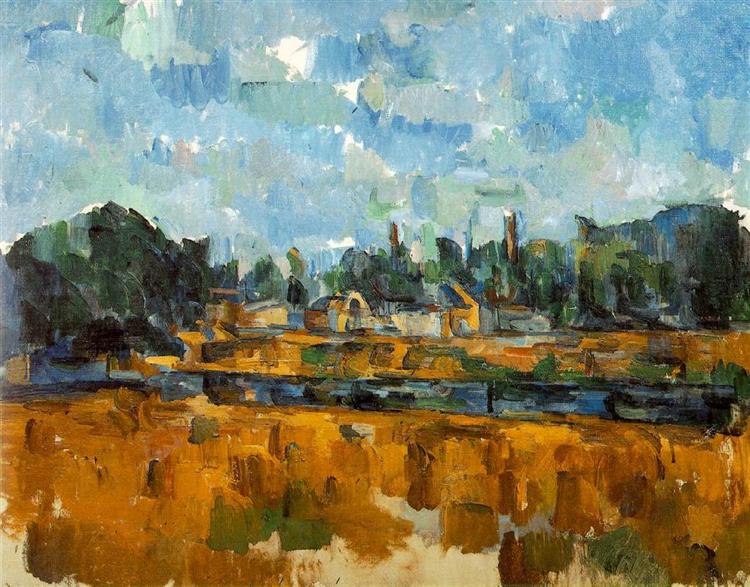Beskrivelse
Paul Cézannes arbejde Dette maleri repræsenterer en manifestation af den innovative og eksperimentelle karakter, der definerede kunstneren, der er bredt anerkendt som en af forløberne for post -impressionisme og derfor en grundlæggende søjle i udviklingen af moderne kunst.
Sammensætningen af "Rio Shores" præsenterer et landskab, hvor bredden af en flod stiger majestætisk, indpakket i en grøn emballage og teksturer, der demonstrerer Cézannes mestring i brugen af farve og form. Gennem korte og tætte børstestræk bygger kunstneren et visuelt rum, der ånder livet, hvor træer er sammenflettet med himlen i en symfoni af blåt og grønt. Maleriets struktur er organiseret i forskellige lag, hvilket antyder en følelse af dybde, der inviterer seeren til at fordybe sig i det naturlige miljø.
Farvepaletten på "Riverbank" er rig og varieret. Cézanne bruger en kombination af grøn, der spænder fra de mørkeste til mere livlige toner sammen med en bemærkelsesværdig anvendelse af blå, der resonerer på himlen og på overfladen af vandet. Til denne palet tilsættes tonerne af brun og terracotta, der kan observeres i marken, såvel som gule berøringer, der belyser scenen. Brugen af farve er grundlæggende i dette arbejde, ikke kun for dets evne til at fremkalde følelser, men også for dets bidrag til den generelle form for sammensætning.
I modsætning til andre landskaber i hans tid søger Cézanne ikke at repræsentere et idyllisk eller idealiseret syn på naturen. Hans tilgang fokuserer på sandheden i landskabet med en lille romantisk fortolkning, der afslører en dyb forbindelse med hverdagens virkelighed. Denne ærlighed i repræsentation er det, der adskiller hans arbejde og bevæger det væk fra den romantiske tradition; I stedet finder vi en tilgang, der fejrer både skønheden og ufuldkommenheden i den naturlige verden.
Et særligt bemærkelsesværdigt aspekt af "flodbred" er manglen på menneskelige figurer, et element, der kan betragtes som usædvanligt i et landskabsarbejde i denne æra. Fraværet af karakterer inviterer seerne til at udforske miljøet som et rent og ubeboet rum, hvilket antyder, at naturen i deres mest rå tilstand på en eller anden måde er et sted for tilflugt og kontemplation. Denne beslutning kunne fortolkes som en refleksion over menneskets forhold og sit miljø, et tilbagevendende tema i Cézannes arbejde og andre post -impressionistiske kunstnere, der udfordrede de etablerede normer.
Teknikken til anvendelse af maling på "Riverbank" fortjener også opmærksomhed. Cézanne er kendt for sin brug af "berøring" eller "børstestræk", der i dette arbejde manifesterer sig i en klar afgrænsning af naturlige former uden den grundige præcision, der kendetegner andre kunstmestre Moderne. I stedet for at skabe en blødhed eller poleret finish, foretrækker den at forlade selve spørgsmålet om malingen synlig, hvilket tilføjer en taktil og følelsesmæssig dimension til landskabet.
På denne måde er "River Banks" mere end en simpel repræsentation af et landskab; Det er en udforskning af farve, form og opfattelse. Gennem sit arbejde inviterer Cézanne os til at overveje vores forhold til det naturlige miljø og viser, at skønhed findes i oprigtigheden af repræsentation og dialog mellem kunstneren og hans emne. Således eksemplificerer dette maleri ikke kun Cézannes karakteristiske stil, men også dets vedvarende indflydelse på efterfølgende kunstneriske strømme. Dens evne til at tilføre livet i landskabet gennem sin unikke behandling af former og farver inspirerer fortsat og resonerer i moderne kunst.
KUADROS ©, en berømt maling på din væg.
Håndlavede olie -malerier med kvaliteten af professionelle kunstnere og den karakteristiske segl af KUADROS ©.
Billeder Reproduktionstjeneste med tilfredshedsgaranti. Hvis du ikke er helt tilfreds med kopien af dit maleri, refunderer vi dine penge 100%.

